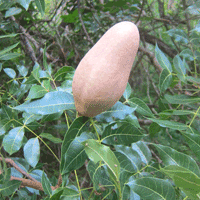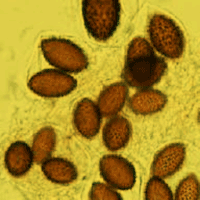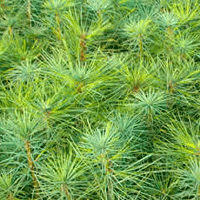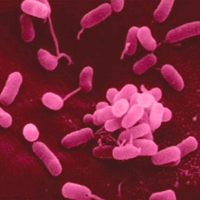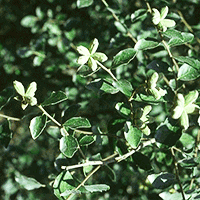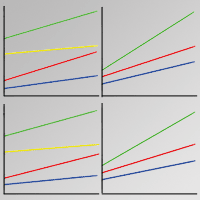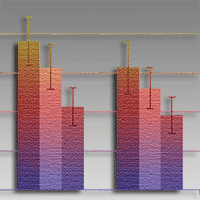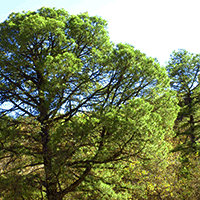
Fertilisation of Quercus seedlings inoculated with Tuber melanosporum: effects on growth and mycorrhization of two host species and two inoculation methods
Sergi Garcia-Barreda (1-2) , Sara Molina-Grau (3), Santiago Reyna (4)
iForest - Biogeosciences and Forestry, Volume 10, Issue 1, Pages 267-272 (2016)
doi: https://doi.org/10.3832/ifor2096-009
Published: Dec 13, 2016 - Copyright © 2016 SISEF
Research Articles
Abstract
Modern truffle cultivation is based on use of inoculated seedlings, which should exhibit highly colonised roots as well as a vegetative quality enhancing field plant performance. However, poor shoot and fine root growth has been a frequent issue in inoculated Quercus seedlings production. Fertilisation is a common solution in forest nurseries, but high fertilisation levels have been found to inhibit the formation of ectomycorrhizas of many fungal species. The influence of slow-release fertilisation (52 mg N, 26 mg P and 36 mg K per seedling) on growth and ectomycorrhizal status of Tuber melanosporum-inoculated seedlings was evaluated. Host species Quercus ilex and Quercus faginea and inoculation methods involving root-dipping and root-powdering were tested. Fertilisation increased weight of both host species without significant detrimental effects on ectomycorrhizal colonisation, showing that it can be effectively used in inoculated seedlings production. Both host species showed similar response to fertilisation. The inoculation method affected seedling weight and ectomycorrhizal status, suggesting that some inoculant carriers are able to damage Quercus development and T. melanosporum colonisation. The study provided an important basis for fine-tuning the use of fertilisers in truffle-inoculated seedling production.
Keywords
Fertilisation, Seedling, Nursery, Ectomycorrhizal, Inoculation
Authors’ Info
Authors’ address
Unidad de Recursos Forestales, Centro de Investigación y Tecnología Agroalimentaria de Aragón (CITA), Avda. Montañana 930, 50059 Zaragoza (Spain)
Centro de Investigación y Experimentación en Truficultura de la Diputación de Huesca, Polígono Fabardo s/n, 22430 Graus (Spain)
Fundación Centro de Estudios Ambientales del Mediterráneo, C/ Charles Darwin 14 Parque Tecnológico, 46980 Paterna (Spain)
ETS Ingeniería Agronómica y del Medio Natural, Universitat Politècnica de València, Camino de Vera s/n, 46021 Valencia (Spain)
Corresponding author
Paper Info
Citation
Garcia-Barreda S, Molina-Grau S, Reyna S (2016). Fertilisation of Quercus seedlings inoculated with Tuber melanosporum: effects on growth and mycorrhization of two host species and two inoculation methods. iForest 10: 267-272. - doi: 10.3832/ifor2096-009
Academic Editor
Andrea Cutini
Paper history
Received: Apr 27, 2016
Accepted: Aug 22, 2016
First online: Dec 13, 2016
Publication Date: Feb 28, 2017
Publication Time: 3.77 months
Copyright Information
© SISEF - The Italian Society of Silviculture and Forest Ecology 2016
Open Access
This article is distributed under the terms of the Creative Commons Attribution-Non Commercial 4.0 International (https://creativecommons.org/licenses/by-nc/4.0/), which permits unrestricted use, distribution, and reproduction in any medium, provided you give appropriate credit to the original author(s) and the source, provide a link to the Creative Commons license, and indicate if changes were made.
Web Metrics
Breakdown by View Type
Article Usage
Total Article Views: 51613
(from publication date up to now)
Breakdown by View Type
HTML Page Views: 42488
Abstract Page Views: 3311
PDF Downloads: 4630
Citation/Reference Downloads: 35
XML Downloads: 1149
Web Metrics
Days since publication: 3289
Overall contacts: 51613
Avg. contacts per week: 109.85
Citation Metrics
Article Citations
Article citations are based on data periodically collected from the Clarivate Web of Science web site
(last update: Mar 2025)
Total number of cites (since 2017): 8
Average cites per year: 0.89
Publication Metrics
by Dimensions ©
Articles citing this article
List of the papers citing this article based on CrossRef Cited-by.
References
Quatre étapes de l’amélioration d’un produit au travers d’un quart de siècle de coopération entre l’INRA et Agri-Truffe [Four steps for the improvement of a product in a quarter of century of cooperation between INRA and Agri-Truffe]. In: Proceedings of the "Vè Congrès International Science et Culture de la Truffe" (Sourzat P ed). Aix-en-Provence (France), 4-6 March 1999. Fédération Française des Trufficulteurs, Marseille, France, pp. 293-295. [in French]
Gscholar
Effects of the initial level of mycorrhization of young plants inoculated with Tuber melanosporum. In: Abstracts book of “IV International Workshop on Edible Mycorrhizal Mushrooms (IWEMM4)”. Murcia (Spain) 28 Nov - 2 Dec 2005. Universidad de Murcia, Murcia, Spain, pp. 32.
Gscholar
Un nuevo método de inoculación de Quercus ilex L. por Tuber melanosporum Vitt. [A new method of Quercus ilex L. inoculation by Tuber melanosporum Vitt.]. Revista Montes 46: 40-43. [in Spanish]
Gscholar
Influencia del método de inoculación, del tipo de substrato y de la procedencia de la trufa, en la micorrización de Quercus ilex L. por Tuber melanosporum Vitt. y en la supervivencia de las plantas [Influence of inoculation method, kind of substrate and origin of truffle on Quercus ilex L. mycorrhization by Tuber melanosporum Vitt. and plant survival]. In: Proceedings of the “Vè Congrès International Science et Culture de la Truffe” (Sourzat P ed). Aix-en-Provence (France) 4-6 March 1999. Fédération Française des Trufficulteurs, Marseille, France, pp 296-299. [in Spanish]
Gscholar
Mycorrhizae. In: “The Container Tree Nursery Manual, Vol. 5. The biological component: nursery pests and mycorrhizae” (Landis TD, Tinus RW, McDonald SE, Barnett JP eds). USDA Forest Service, Washington, USA, pp. 101-171.
Gscholar
Application pratique de la symbiose ectomycorhizienne: production a grande echelle de plants mycorhizes par la truffe (Tuber melanosporum Vitt.) [Practical application of ectomycorrhizal symbiosis: large-scale production of plants mycorrhized by truffle]. Mushroom Science 10: 483-505.
Gscholar
Influence de l’azote et du phosphore sur la mycorhization de Quercus pubescens Willd. par Tuber melanosporum Vitt. en conditions contrôlées [Influence of nitrogen and phosphorus on mycorrhiza formation by Quercus pubescens Willd. and Tuber melanosporum Vitt. under controlled conditions]. In: “Les mycorhizes, partie intégrante de la plante: biologie et perspectives d’utilisation”. (Gianinazzi S, Gianinazzi-Pearson V, Trouvelot A eds). INRA seminar no. 13, INRA, Dijon, France, pp. 147-154. [in French]
Gscholar
Methodology for certification of Quercus ilex seedlings inoculated with Tuber melanosporum for commercial application. In: Abstracts booklet of “1st International Conference on Mycorrhizae (ICOM1)” (Szaro TM, Bruns TD eds). Berkeley (California, USA) 4-9 Aug 1996. University of California, Berkeley, California, USA, p 34.
Gscholar
Ecología de la trufa y las áreas truferas [Ecology of truffle and truffle areas]. In: “Truficultura: Fundamentos y Técnicas” (Reyna S ed). Ed. Mundi-Prensa, Madrid, Spain, pp. 153-208. [in Spanish]
Gscholar
Taming the truffle. Timber Press, Portland, USA, pp. 304.
Gscholar
Viveros y producción de planta micorrizada [Nurseries and production of mycorrhizal plants]. In: “Truficultura: Fundamentos y técnicas” [Trufficulture: Principles and Techniques] (Reyna S ed). Ed. Mundi-Prensa, Madrid, Spain, pp. 209-236.
Gscholar
Experiments on the life cycle and factors affecting reproduction of Sphaerosporella brunnea provide evidence for rapid asexual propagation by conidiospores and for homothallism in an ectomycorrhizal competitor of cultivated truffle species. Fungal Ecology 8: 59-65.
CrossRef | Gscholar
Principe de précaution en trufficulture [The principle of precaution in truffle cultivation]. Station d’Expérimentation sur la Truffe, Le Montat, France, pp 72. [in French]
Gscholar
Quercus ilex L. In: “Producción y manejo de semillas y plantas forestales. Tomo II” [Production and handling of forest seeds and seedlings. Vol. II] (Pemán J, Navarro-Cerrillo RM, Nicolás-Peragón JL, Prada-Sáez MA, Serrada R eds). Organismo Autónomo Parques Nacionales, Ministerio de Agricultura, Alimentación y Medio Ambiente, Madrid, Spain, pp. 226-250. [in Spanish]
Gscholar
Quercus faginea Lam. - Quercus humilis Mill. In: “Producción y manejo de semillas y plantas forestales. Tomo II” [Production and handling of forest seeds and seedlings. Vol. II] (Pemán J, Navarro-Cerrillo RM, Nicolás-Peragón JL, Prada-Sáez MA, Serrada R eds). Organismo Autónomo Parques Nacionales, Ministerio de Agricultura, Alimentación y Medio Ambiente, Madrid, Spain, pp. 206-225. [in Spanish]
Gscholar


